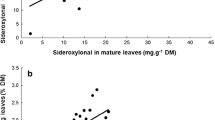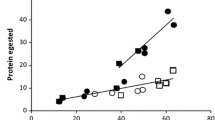Summary
The effects of artificial defoliation of birch trees in the previous year on the consumption and utilization of food by a geometrid larva, Epirrita autumnata, were studied in laboratory. The leaves were collected from two sites on a slope of a fell. Defoliation had a significant retarding effect on approximate digestibility, efficiency of conversion of ingested food, relative consumption rate and relative growth rate but not on efficiency of conversion of digested food. The effects were to the same direction with leaves from the two sites, but the response was stronger with leaves from the zone defoliated by Epirrita during mid-sixties. The defensive nature of the response(s) of birch to defoliation is discussed in the light of these results. It is concluded that contrary to the hypothesis of Moran and Hamilton (1980) no increase in the consumption incurred by individual trees could be shown in this system.
Similar content being viewed by others
References
Coley PD (1983) Herbivory and defensive characteristics of tree species in a lowland tropical forest. Ecol Monogr 53:209–233
Dadd RH (1960) Observations on the palatability and utilization of food by locusts, with particular reference to the interpretation of performance in growth trials using synthetic diets. Ent Exp and Appl 3:283–304
Feeny PP (1970) Seasonal changes in oak leaf tannins and nutrients as a cause of spring feeding by winter-moth caterpillars. Ecology 51:656–681
Feeny PP (1975) Biochemical coevolution between plants and their insect herbivores. Pp 3–19 in Gilbert LE, Raven PH (eds) Coevolution of animals and plants. Univ Texas Press, Austin
Feeny PP (1976) Plant apparency and chemical defense. Rec Adv Phytochem 10:1–40
Haukioja E (1980) On the role of plant defences in the fluctuation of herbivore populations. Oikos 35:202–213
Haukioja E (1982) Inducible defences of white birch to a geometrid defoliator, Epirrita autumnata. Proc. 5th Int Symp Insect-Plant Relationships. Pudoc, Wageningen, pp 199–203
Haukioja E, Niemelä P (1974) Growth and energy requirements of the larvae of Dineura virididorsata (Retz.) (Hym., Tenthredinidae) and Oporinia autumnata (Bkh.) (Lep., Geometridae) feeding on birch. Ann Zool Fennici 11:207–211
Haukioja E, Niemelä P, Iso-Iivari L, Ojala H, Aro E-M (1978) Birch leaves as a resource for herbivores. I. Variation in the suitability of leaves. Rep Kevo Subarctic Res Stat 14:5–12
Kallio P, Lehtonen J (1975) On the ecocatastrophe of birch forests caused by Oporinia autumnata (Bkh.) and the problem of reforestation. In: Wielgolaski FE (ed) Fennoscandian Tundra Ecosystems, Part 2: Animals and systems analysis. Ecological studies. Analysis and synthesis, 17. Springer Berlin Heidelberg New York, p 337
Lincoln DE, Newton TS, Ehrlich PR, Williams KS (1982) Coevolution of the checkerspot bufferfly Euphydryas chalcedona and its larval food plant Diplacus aurantiacus: Larval response to protein and leaf resin. Oecologia (Berlin) 52:216–223
Martin JS, Martin MM (1982) Tannin assays in ecological studies: Lack of correlation between phenolics, proanthosyanidins and protein-precipitating constituents in mature foliage of six oak species. Oecologia (Berlin) 54:205–211
McGinnis AJ, Kasting R (1967) Dietary cellulose: effec on food consumption and growth of a grasshopper. Can J Zool 45:365–367
Moran N, Hamilton WD (1980) Low nutritive quality as defense against herbivores. J Theor Biol 86:247–254
Price PW, Bouton CE, Gross P, McPheron BA, Thompson JN, Weis AE (1980) Interactions among three trophic levels: Influence of plants on interactions between insect herbivores and natural enemies. Ann Rev Ecol Syst 11:41–65
Rausher MD (1981) Host plant selection by Battus philenor butterflies: The roles of predation, nutrition, and plant chemistry. Ecol Monogr 51:1–20
Rhoades DF, Cates RG (1976) Toward a general theory of plant antiherbivore chemistry. Rec Adv Phystochem 10:168–213
Schulz JC, Baldwin IT (1982) Oak leaf quality declines in response to defoliation by Gypsy moth larvae. Science 217:149–151
Slansky F Jr (1982) Insect nutrition: an adaptationist's perspective. Florida Entomol 65:45–71
Slansky F Jr, Feeny P (1977) Stabilization of the rate of nitrogen accumulation by larvae of the cabbage butterfly on wild and cultivated food plants. Ecol Monogr 47:209–228
Tenow O (1972) The outbreaks of Oporinia autumata Bkh. and Operophthera spp. (Lep., Geometridae) in the Scandinavian mountain chain and northern Finland 1862–1968. Zool Bidrag Uppsala, Suppl. 2:1–107
Tuomi J, Niemelä P, Haukioja E, Siren S, Neuvonen S (1984) Nutrient stress. An explanation for plant anti-herbivore responses to defoliation. Oecologia (Berlin) 61:208–210
Author information
Authors and Affiliations
Rights and permissions
About this article
Cite this article
Neuvonen, S., Haukioja, E. Low nutritive quality as defence against herbivores: induced responses in birch. Oecologia 63, 71–74 (1984). https://doi.org/10.1007/BF00379787
Received:
Issue Date:
DOI: https://doi.org/10.1007/BF00379787




